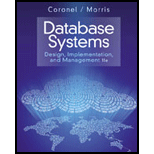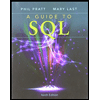
Concept explainers
a)
Creation of an
- To create an information system an initial study and following phases are need to be made by the designer because they will create an impact to the design of the
database . - The information is collected in order to establish details about the entities, relationships among the entities generated.
- Business rules that are shaped up through relationships, connectivity and cardinalities are being obtained and collected through designer.
Question that can be asked in order to create an information system:
The below are some of the sample questions that can impact the design of the database:
- Is it required to develop the database for all departments at once or whether it is required to design and implement the database for one particular department?
- What will the design approach required that could affect the process of designing?
- What type of development is required, one module at a time or integrated system approaches (Example: Billing, production, shipping and inventory)?
- What type of tracking system is required that is in terms of tracking the nuts and bolts through lot number, by shift, by production, by type or by department?
- What type of tracking system is required for the suppliers of each batch that is in terms raw materials used in the production of the nuts and bolts?
- Is it required to track the customer information regarding the receive summary of nuts and bolts based on batches?
- What type of reporting system is required that is what type of reporting requirements are required and who requires the distribution report details needs to be specified?
Effect of the questions that are asked:
The answers to the above question affect the database design in conceptual and in logical way along with the implementation, testing made with the subsequent operations.
b)
Creation of an information system:
- To create an information system an initial study and following phases are need to be made by the designer because they will create an impact to the design of the database.
- The information is collected in order to establish details about the entities, relationships among the entities generated.
- Business rules that are shaped up through relationships, connectivity and cardinalities are being obtained and collected through designer.
Question that can be asked in order to create an information system:
The below are some of the sample questions that can impact the design of the database:
- Is it required to develop the database for all departments at once or whether it is required to design and implement the database for one particular department?
- What will the design approach required that could affect the process of designing?
- What type of development is required, one module at a time or integrated system approaches (Example: Billing, production, shipping and inventory)?
- What type of tracking system is required that is in terms of tracking the nuts and bolts through lot number, by shift, by production, by type or by department?
- What type of tracking system is required for the suppliers of each batch that is in terms raw materials used in the production of the nuts and bolts?
- Is it required to track the customer information regarding the receive summary of nuts and bolts based on batches?
- What type of reporting system is required that is what type of reporting requirements are required and who requires the distribution report details needs to be specified?
Effect of the questions that are asked:
The answers to the above question affect the database design in conceptual and in logical way along with the implementation, testing made with the subsequent operations.
Trending nowThis is a popular solution!

Chapter 9 Solutions
Database Systems: Design, Implementation, & Management
- what is a feature in the Windows Server Security Compliance Toolkit, thank you.arrow_forwardYou will write a program that allows the user to keep track of college locations and details about each location. To begin you will create a College python class that keeps track of the csollege's unique id number, name, address, phone number, maximum students, and average tuition cost. Once you have built the College class, you will write a program that stores College objects in a dictionary while using the College's unique id number as the key. The program should display a menu in this order that lets the user: 1) Add a new College 2) Look up a College 4) Delete an existing College 5) Change an existing College's name, address, phone number, maximum guests, and average tuition cost. 6) Exit the programarrow_forwardShow all the workarrow_forward
- Show all the workarrow_forward[5 marks] Give a recursive definition for the language anb2n where n = 1, 2, 3, ... over the alphabet Ó={a, b}. 2) [12 marks] Consider the following languages over the alphabet ={a ,b}, (i) The language of all words that begin and end an a (ii) The language where every a in a word is immediately followed by at least one b. (a) Express each as a Regular Expression (b) Draw an FA for each language (c) For Language (i), draw a TG using at most 3 states (d) For Language (ii), construct a CFG.arrow_forwardQuestion 1 Generate a random sample of standard lognormal data (rlnorm()) for sample size n = 100. Construct histogram estimates of density for this sample using Sturges’ Rule, Scott’s Normal Reference Rule, and the FD Rule. Question 2 Construct a frequency polygon density estimate for the sample in Question 1, using bin width determined by Sturges’ Rule.arrow_forward
- Generate a random sample of standard lognormal data (rlnorm()) for sample size n = 100. Construct histogram estimates of density for this sample using Sturges’ Rule, Scott’s Normal Reference Rule, and the FD Rule.arrow_forwardCan I get help with this case please, thank youarrow_forwardI need help to solve the following, thank youarrow_forward
 Principles of Information Systems (MindTap Course...Computer ScienceISBN:9781285867168Author:Ralph Stair, George ReynoldsPublisher:Cengage Learning
Principles of Information Systems (MindTap Course...Computer ScienceISBN:9781285867168Author:Ralph Stair, George ReynoldsPublisher:Cengage Learning Principles of Information Systems (MindTap Course...Computer ScienceISBN:9781305971776Author:Ralph Stair, George ReynoldsPublisher:Cengage Learning
Principles of Information Systems (MindTap Course...Computer ScienceISBN:9781305971776Author:Ralph Stair, George ReynoldsPublisher:Cengage Learning A Guide to SQLComputer ScienceISBN:9781111527273Author:Philip J. PrattPublisher:Course Technology Ptr
A Guide to SQLComputer ScienceISBN:9781111527273Author:Philip J. PrattPublisher:Course Technology Ptr Database Systems: Design, Implementation, & Manag...Computer ScienceISBN:9781305627482Author:Carlos Coronel, Steven MorrisPublisher:Cengage Learning
Database Systems: Design, Implementation, & Manag...Computer ScienceISBN:9781305627482Author:Carlos Coronel, Steven MorrisPublisher:Cengage Learning Database Systems: Design, Implementation, & Manag...Computer ScienceISBN:9781285196145Author:Steven, Steven Morris, Carlos Coronel, Carlos, Coronel, Carlos; Morris, Carlos Coronel and Steven Morris, Carlos Coronel; Steven Morris, Steven Morris; Carlos CoronelPublisher:Cengage Learning
Database Systems: Design, Implementation, & Manag...Computer ScienceISBN:9781285196145Author:Steven, Steven Morris, Carlos Coronel, Carlos, Coronel, Carlos; Morris, Carlos Coronel and Steven Morris, Carlos Coronel; Steven Morris, Steven Morris; Carlos CoronelPublisher:Cengage Learning Fundamentals of Information SystemsComputer ScienceISBN:9781337097536Author:Ralph Stair, George ReynoldsPublisher:Cengage Learning
Fundamentals of Information SystemsComputer ScienceISBN:9781337097536Author:Ralph Stair, George ReynoldsPublisher:Cengage Learning





